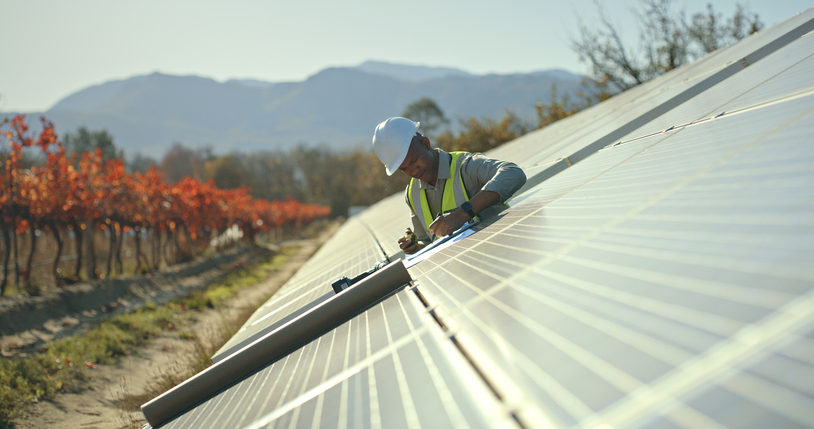More Than 40% of World’s Electricity Came From Zero-Carbon Sources in 2023
Investments in renewables continue to outpace fossil fuels, a BloombergNEF report finds
Zero-carbon technologies comprised more than 40% of global electricity generation for the first time in 2023, according to a report released Tuesday from BloombergNEF.
Renewable energy sources like wind and solar made up 17% of total electricity generation, and hydroelectric and nuclear power contributed 24%. Fossil fuels including coal and natural gas produced 57% of global electricity last year.
“We’ve consistently seen the penetration of renewables rising every year, and this year we hit quite a few milestones that had felt harder to reach in past years,” said Meredith Annex, head of clean power at BNEF.
One such milestone: Solar and wind represented more than 90% of global energy capacity additions last year, a step up from 2022. Global wind capacity also crossed the one-terawatt threshold. And Brazil, the country with the cleanest power mix of the G-20 economies, hit 88% renewable power generation in 2023.
“It just shows the momentum that the space is having. A lot of that does tie into the investment story, where you’ve got rising—skyrocketing, honestly—investment into solar,” Annex said.
Mainland China accounted for almost a third of total renewable energy output last year. The country recently reached its 2030 target for wind and solar energy six years early, according to a statement from its National Energy Administration, and it has pulled back on permits for new coal-fired power plants. The country’s rapid deployment of renewables has some analysts wondering if it will reach peak fossil fuel consumption this year. Declining emissions in China would signal a turning point because it is the world’s largest polluter, comprising nearly a third of global greenhouse gas emissions, according to the International Energy Agency.
Despite rapid growth in renewables, countries’ current commitments aren’t sufficient to limit global warming to 1.5 degrees Celsius, the goal outlined in the 2015 Paris Agreement, according to the IEA. Advanced economies would need to slash emissions by 80% by 2035 to meet the goal.
At last December’s COP28, a global climate conference hosted by the United Nations, participating countries agreed to triple renewable energy capacity by 2030. BNEF has forecast that achieving this goal would require investments in renewables to increase to 1.6 times 2023 levels from 2024 to 2030.
So far, that increase hasn’t materialised. Global investments in renewables are roughly on par with 2023 levels, at $313 billion in the first half of 2024, according to the new BNEF analysis. “We’re expecting steady growth, but steady growth does not get you to net zero,” Annex said.
The topline numbers obscure bigger changes under the surface. Average spending in the U.S. is up by about 63% compared with levels before the 2022 Inflation Reduction Act, which offers generous subsidies and tax breaks to promote decarbonisation. And while Chinese investment is actually down 4% from the same period in 2023, Annex said the dip is due to cheaper equipment for wind and solar, not a decline in demand.
The second half of this year will be a “defining moment,” for the investment landscape, Annex said. Steady growth “is definitely a positive, and it could be a sign that the industry as a whole is reaching a new kind of status quo, but we need to help expand even faster if we’re going to be in line with net zero.”
 Copyright 2020, Dow Jones & Company, Inc. All Rights Reserved Worldwide. LEARN MORE
Copyright 2020, Dow Jones & Company, Inc. All Rights Reserved Worldwide. LEARN MORE
A divide has opened in the tech job market between those with artificial-intelligence skills and everyone else.
A 30-metre masterpiece unveiled in Monaco brings Lamborghini’s supercar drama to the high seas, powered by 7,600 horsepower and unmistakable Italian design.
A divide has opened in the tech job market between those with artificial-intelligence skills and everyone else.
There has rarely, if ever, been so much tech talent available in the job market. Yet many tech companies say good help is hard to find.
What gives?
U.S. colleges more than doubled the number of computer-science degrees awarded from 2013 to 2022, according to federal data. Then came round after round of layoffs at Google, Meta, Amazon, and others.
The Bureau of Labor Statistics predicts businesses will employ 6% fewer computer programmers in 2034 than they did last year.
All of this should, in theory, mean there is an ample supply of eager, capable engineers ready for hire.
But in their feverish pursuit of artificial-intelligence supremacy, employers say there aren’t enough people with the most in-demand skills. The few perceived as AI savants can command multimillion-dollar pay packages. On a second tier of AI savvy, workers can rake in close to $1 million a year .
Landing a job is tough for most everyone else.
Frustrated job seekers contend businesses could expand the AI talent pipeline with a little imagination. The argument is companies should accept that relatively few people have AI-specific experience because the technology is so new. They ought to focus on identifying candidates with transferable skills and let those people learn on the job.
Often, though, companies seem to hold out for dream candidates with deep backgrounds in machine learning. Many AI-related roles go unfilled for weeks or months—or get taken off job boards only to be reposted soon after.
Playing a different game
It is difficult to define what makes an AI all-star, but I’m sorry to report that it’s probably not whatever you’re doing.
Maybe you’re learning how to work more efficiently with the aid of ChatGPT and its robotic brethren. Perhaps you’re taking one of those innumerable AI certificate courses.
You might as well be playing pickup basketball at your local YMCA in hopes of being signed by the Los Angeles Lakers. The AI minds that companies truly covet are almost as rare as professional athletes.
“We’re talking about hundreds of people in the world, at the most,” says Cristóbal Valenzuela, chief executive of Runway, which makes AI image and video tools.
He describes it like this: Picture an AI model as a machine with 1,000 dials. The goal is to train the machine to detect patterns and predict outcomes. To do this, you have to feed it reams of data and know which dials to adjust—and by how much.
The universe of people with the right touch is confined to those with uncanny intuition, genius-level smarts or the foresight (possibly luck) to go into AI many years ago, before it was all the rage.
As a venture-backed startup with about 120 employees, Runway doesn’t necessarily vie with Silicon Valley giants for the AI job market’s version of LeBron James. But when I spoke with Valenzuela recently, his company was advertising base salaries of up to $440,000 for an engineering manager and $490,000 for a director of machine learning.
A job listing like one of these might attract 2,000 applicants in a week, Valenzuela says, and there is a decent chance he won’t pick any of them. A lot of people who claim to be AI literate merely produce “workslop”—generic, low-quality material. He spends a lot of time reading academic journals and browsing GitHub portfolios, and recruiting people whose work impresses him.
In addition to an uncommon skill set, companies trying to win in the hypercompetitive AI arena are scouting for commitment bordering on fanaticism .
Daniel Park is seeking three new members for his nine-person startup. He says he will wait a year or longer if that’s what it takes to fill roles with advertised base salaries of up to $500,000.
He’s looking for “prodigies” willing to work seven days a week. Much of the team lives together in a six-bedroom house in San Francisco.
If this sounds like a lonely existence, Park’s team members may be able to solve their own problem. His company, Pickle, aims to develop personalised AI companions akin to Tony Stark’s Jarvis in “Iron Man.”
Overlooked
James Strawn wasn’t an AI early adopter, and the father of two teenagers doesn’t want to sacrifice his personal life for a job. He is beginning to wonder whether there is still a place for people like him in the tech sector.
He was laid off over the summer after 25 years at Adobe , where he was a senior software quality-assurance engineer. Strawn, 55, started as a contractor and recalls his hiring as a leap of faith by the company.
He had been an artist and graphic designer. The managers who interviewed him figured he could use that background to help make Illustrator and other Adobe software more user-friendly.
Looking for work now, he doesn’t see the same willingness by companies to take a chance on someone whose résumé isn’t a perfect match to the job description. He’s had one interview since his layoff.
“I always thought my years of experience at a high-profile company would at least be enough to get me interviews where I could explain how I could contribute,” says Strawn, who is taking foundational AI courses. “It’s just not like that.”
The trouble for people starting out in AI—whether recent grads or job switchers like Strawn—is that companies see them as a dime a dozen.
“There’s this AI arms race, and the fact of the matter is entry-level people aren’t going to help you win it,” says Matt Massucci, CEO of the tech recruiting firm Hirewell. “There’s this concept of the 10x engineer—the one engineer who can do the work of 10. That’s what companies are really leaning into and paying for.”
He adds that companies can automate some low-level engineering tasks, which frees up more money to throw at high-end talent.
It’s a dynamic that creates a few handsomely paid haves and a lot more have-nots.
Australia’s market is on the move again, and not always where you’d expect. We’ve found the surprise suburbs where prices are climbing fastest.
A 30-metre masterpiece unveiled in Monaco brings Lamborghini’s supercar drama to the high seas, powered by 7,600 horsepower and unmistakable Italian design.






















